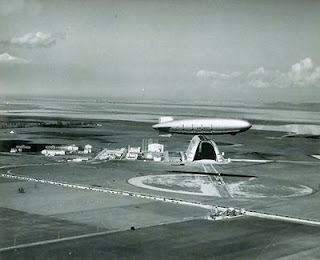 |
| The USS Macon heads into Hangar One at Moffett Field in the 1930s. |
 |
| Hangar One in a photo I took April 27, 2011. You can't see the changes yet, but they should be obvious pretty soon. |
They have begun to take the skin off the famous Hangar One at Moffett Field.
It is one of the largest free-standing structures in the United States and, next to the Golden Gate Bridge, is perhaps the best known man made landmark on the West Coast. It was built in the 1930s to house the airships the Navy hoped would mark the future of Naval aviation.
It is one of the largest free-standing structures in the United States and, next to the Golden Gate Bridge, is perhaps the best known man made landmark on the West Coast. It was built in the 1930s to house the airships the Navy hoped would mark the future of Naval aviation.
That dream died when the enormous blimps proved impractical and dangerous. But the hangar survived and during World War II and the Cold War was re-purposed many times. Flight cadet Jimmy Stewart trained in its shadow.
If you've ever flown into or out of San Francisco or San Jose you've seen it. It is just a few miles from where I grew up and it can be found in the northeast corner of the map my father sent to his father in Alabama, when Dad bought his first lot in Los Altos, Ca.
Here is a detail from that map, which shows the blimp, upper right. The base was actually in Mountain View, but the Navy decided to call it Sunnyvale since the words "mountain" and "view" might conjure up visions of dangerous landings. Silly. The field is on a sunny outcropping into San Francisco Bay.
In 2008, the National Trust for Historic Preservation placed Hangar One on its list of America's Most Endangered Places. The entire airfield is listed on the National Register of Historic Places.
The U.S.S. Macon out over Moffett and Hangar One, 1930s.
There seems to be good news on that front this week as NASA, which now has Hangar One under its aegis, has published a "request for information" seeking contractors interested in restoring the building. Which is a good thing, since also this week, a contractor began tearing the walls, or "skin" off Hangar One.
So, preservationists have had enough challenges to fill a blimp load of hangars. Moffett Field Historical Society President Herb Parsons says he is encouraged that NASA seems to have a plan to "re-skin" the blimp, but remains skeptical of what the future holds. Bob Moss, of the Moffett Field Restoration Advisory Board, is trying to envision what Hangar One is going to look like as just a frame of steel girders.
That is how the historic building will look--a giant skeleton--until the money is found to re-cover it. The work of removing the present skin is expected to be finished in 2012.
And I think that is when preservationists all over the state and the country will start a ruckus. The 200-foot-high skeleton, ten football fields wide and deep, will make someone take action. It is then, I suspect, that the money will materialize from some government fund (or a Silicon Valley checkbook) to restore this stunning monument.
In the meantime, volunteers keep on plugging. The Moffett Historical Society Museum is sponsoring a fundraiser in conjunction with the Wings of Freedom Tour at Moffett Field May 21-29. World War II warbirds, including a B-17, a B-24, and a B-25 will be on hand for tours and flights. You can buy tickets ahead of time ($10) or at the gate. Or you could just send a donation to the Historical Society so they could continue their work. They are all volunteers (and I am now one of them). Here's the contact information:
Moffett Field Historical Society Museum
P.O. Box 16, Moffett Field, CA 94035-0016
t: 650/964-4024
f: 650/964-4028
e: moffettmuseum@sbcglobal.net
Moffett Field Historical Society
Subscribe to Robin Chapman News




No comments:
Post a Comment